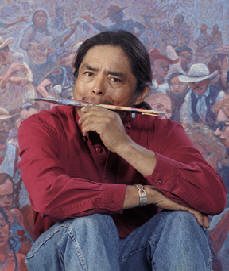By the time you read this piece, we should know if all the hype of this week’s back-to-back snowstorms lived up to the expectation. Two to three feet we are told, and anything less will be a letdown.
With natural emergency what it is today, we have to be extra careful and prepare for such ominous predictions. This elevated sense of danger and adventure brings to mind the winter of 1967. I was 12 years old and living with my surrogate family, the B.I.A. boarding school. I was safe and warm in those concrete bunkers behind hurricane fences. It started snowing on Tue, Dec. 14, or close to that. I remember it was Tuesday because it was my Library day and I watched those big fluffy and beautifully designed flakes floating down, first in a light, airy descent, through the library window. No forewarning was given as far as I knew. This was just another good snow blessing for the thirsty earth. After all, this is what we pray for … and it snowed.
The end of the first week found us in waist-deep snow. Shoveling those miles of government sidewalks lost its sense of adventure for me in no time. It was a relief when I heard my name called; my parents had come for me for the winter break. The school official had practically shut the school down for the break. Me, my older brother Nelson, our parents and an uncle plowed home on foot three-and-a-half miles over the mesa. It took two days. The tops of our heads were the only visible parts of us.
Once home, I did not venture from the sheepcamp at all that winter. The livestock stayed penned and responsibilities were met through series of snow tunnels. Tunnels from the hogan to the woodpile, to the corral and outhouses. It was the warmest winter I remember due to the fantastic insulating qualities of deep snow. The snow was so deep, my traditional maternal elders wore trousers. Snow had piled up in places eight to 10 feet deep. The radio was tuned to KCLS, a Flagstaff AM station that spoke my language. It kept us informed about what was going on outside of our intensely white world. Raymond Nakai, the Navajo DJ and later a tribal chairman, delivered the emergency message all hours of the day. This connection proved to be so valuable. He told us to draw a huge circle in the snow with ashes to signal helicopters for help. For food drops, a circle with one line across it; for animal feed, a circle with another circle inside; for fuel, an X; for medical attention, a circle with a cross. Our neighbors to the north, the Tallmans, found their hogan accidently bombed by a big bundle of hay because someone drew the circle too close to the hogan.
My landscape changed from rugged pinyon/juniper-studded mesas interrupted by canyons into something surreal and glaringly white. Hogans and sheep camps were completely covered in a deceptively gentle sweep of snow. Smoke from the stovepipes of buried hogans were the only clues that life continued below the surface. I know what Punxsutawney Phil must feel like emerging from his den to assess the possibility of spring. Animals that were away from food and shelter perished. Others survived by eating anything digestible. As the sun melted the snow on tops of trees, goats and mules foraged there. When spring finally came, many tree tops were bare.
Yes, this was the winter of my 12th birthday. I heard choppers overhead through the thinning ice ceilings of our tunnels. The bleatings of baby goats and lambs accompanied the silvery laughter of my mother and grandmother as they went about their chores. There was always hope in hearing their laughter. In early March, we emerged from our icy underworld into the newness that the storm created. The amazing thing is that during this crisis on the reservation in 1968, only one person died. Living on the rez, you have to be prepared.
I hope that we are all safe and warm through this storm, and that you are blessed by the newness that the storm creates.

